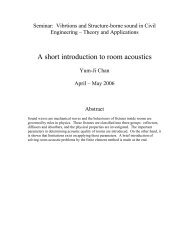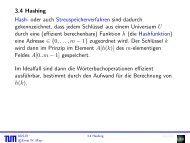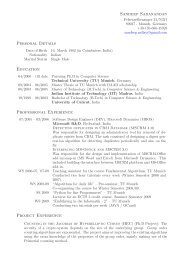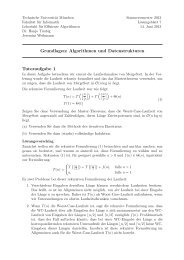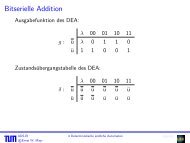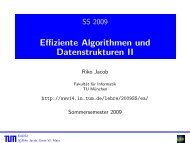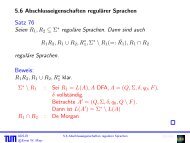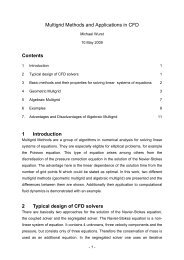Paper [PDF]
Paper [PDF]
Paper [PDF]
You also want an ePaper? Increase the reach of your titles
YUMPU automatically turns print PDFs into web optimized ePapers that Google loves.
Hierarchy TheoremsAnton BankevichJune 24, 2006AbstractIn the paper the hierarchy theorems for certain classes of languages are proved. Severalcases where hierarchy does not occur are discussed.1
Contents1 Introduction 32 Basic Definitions 33 Hierarchy theorems for DTime, DSpace and NTime 33.1 DTime . . . . . . . . . . . . . . . . . . . . . . . . . . . . . . . . . . . . . . . . 33.2 DSpace . . . . . . . . . . . . . . . . . . . . . . . . . . . . . . . . . . . . . . . . 53.3 NTime . . . . . . . . . . . . . . . . . . . . . . . . . . . . . . . . . . . . . . . . 54 Cases where hierarchy does not occur 64.1 GAP Theorem . . . . . . . . . . . . . . . . . . . . . . . . . . . . . . . . . . . . 64.2 Space theorems . . . . . . . . . . . . . . . . . . . . . . . . . . . . . . . . . . . . 72
1 IntroductionThe main idea of hierarchy theorems is as follows. We observe a time or space bounded class,e.g. DT ime(f(n)) and two functions f(n) and g(n). The Hierarchy Theorem states whatassumptions should be taken for f(n) and g(n) so that we could claim that DT ime(f(n)) isnot equal to DT ime(g(n)).2 Basic DefinitionsIn this section we shall define the complexity classes and the types of functions we are goingto deal with.Definition 2.1 DT ime(f(n)) is a set of languages which can be decided by a DTM in f(n)steps. Here f(n) is a time constructible function.Definition 2.2 DSpace(f(n)) is a set of languages which can be decided by DTM using f(n)space. Here f(n) is a space constructible function.Definition 2.3 NT ime(f(n)) is a set of languages which can be decided by NTM in f(n)steps. Here f(n) is a time constructible function.Definition 2.4 For any bounded complexity class CC(f(n)) and Ω, a set of functions, CC(Ω) =∪ f(n)∈Ω CC(f(n))These definitions are certainly well known, but they are presented here because in literatureCC(f(n)) is often used with the same meaning as in our definitions of CC(O(f(n))). We givethese definitions to introduce our notation.Definition 2.5 f : N → N is a time constructible function iff there is a DTM which if givenan input consisting of 1 n constructs f(n) and which prints it on the output tape in f(n) timeat most.Definition 2.6 f : N → N is a space constructible function iff there is a DTM which if givenan input consisting of 1 n constructs f(n) and which prints it on the output tape using f(n)space at most.These definitions are also well known, but in some textbooks they are slightly different. Forexample, one can find definitions where DTM does not print the value of f(n), but it mustwork for exactly f(n) time in the case of time constructible functions or use exactly f(n)space in the case of space constructible functions. But it is quite clear that these definitionsare equivalent.All the proofs in this paper are very technical so we do not give the complete proofs butthe main idea will always be explained.3 Hierarchy theorems for DTime, DSpace and NTime3.1 DTimeTheorem 1 If f(n), g(n) are time constructible functions f(n)log(g(n)) = o(g(n)) andf(n) > n for sufficiently large n ,then DT ime(O(f(n))) DT ime(O(g(n))).3
Proof Obviously DT ime(O(f(n))) ⊂ DT ime(O(g(n))), so we will prove that DT ime(O(f(n))) ≠DT ime(O(g(n))). Therefore we shall construct DTM D such that L(D) (the language whichis decided by D) belongs to DT ime(O(g(n))) and does not belong to DT ime(O(f(n))). Firstwe give the enumeration of all DTMs in the fallowing way: we enumerate the language andthe states of a machine with binary numbers. DTM is just a number of rules which statewhere we should move the head and what we should print on the tape, so all these rules canalso be written as a string in the alphabet {0, 1}. In this way we enumerate all DTMs. Wedefine M k as a DTM which corresponds to k in our enumeration.Then we construct D. D will work with the alphabet {0, 1, $} and it will operate on thestring S in the following way:• If S ≠ k$1 l for certain k and l, then D accepts S (here and thereafter, k as part of thestring means binary representation of k).• If S = k$1 l , then D simulates M k on S for h(n) steps. h(n) will be defined later.– If M k doesn’t exist, D accepts S.– If M k halts within this time and accepts input, D rejects S.– If M k halts within this time and rejects input, D accepts S.– If M k doesn’t halt within this time, D accepts S.1) D ∈ DT ime(O(g(n)))It is easy to see that the checking that the input string is correct takes O(n) time. Therefore,we do not want the second part of the algorithm to work too long. The question is, whatadditional factor for the duration of work of M k the simulation needs. The answer is that thisfactor is logarithmic. It means that the simulation works within O(h(n)log(h(n)) time period.This simulation construction is complicated, so it will not be given here. Here we need h(n)to be such that h(n)log(h(n)) = o(g(n)).2) D /∈ DT ime(O(f(n)))If f(n) = o(h(n)) then for all M k which belong to DTime(f(n)) D will stop evaluationof M k in time for l that is large enough. But when the simulation stops in time, D givesthe answer opposite to the answer of M k , therefore D is not equal to M k for any M k fromDT ime(o(f(n))).Now we find h(n) such that f(n) ≤ h(n) and h(n)log(h(n)) = o(g(n)). Assume h(n) =g(n)log(g(n)). This will be the function which we want, because f(n)log(g(n)) = o(g(n)).h Thiscompletes the proof.⊔⊓Rem 1 The method used in this proof is called diagonalisation: in this method we constructTM which, given some other TM and some word as input, simulates all operations of the givenTM and calculates its own answer from the answer of the given TM. Then we just look at howour machine works if given itself as an input. With the help of this construction we are ableto prove that certain classes do not coincide.The theorem without O also holds:Theorem 2 If f(n), g(n) are time constructible functions f(n)log(g(n)) = o(g(n)) andf(n) > n for sufficiently large n, then DT ime(f(n)) DT ime(g(n)).Proof This theorem can be proved in the same way as the previous one. We only need tog(n)define h(n) as ε for ε which is small enough.⊔⊓log(g(n))4
3.2 DSpaceTheorem 3 If f(n), g(n) are space constructible functions f(n) = o(g(n)) and f(n) > log(n)for sufficiently large n, then DSpace(O(f(n))) DSpace(O(g(n))).Rem 2 As we can see, here we do not need any additional logarithmic factor.Proof We use the same enumeration as in the proof of Theorem 1. Here we also have anobvious inclusion, so our aim is to prove that these classes are not equal. The construction ofD is as follows(S is an input string here):• If S ≠ k$1 l for certain k and l, then D accepts S.• If S = k$1 l , then D simulates M k on S for h(n)2 h(n) steps while not more than h(n)space is used.– If M k does not exist, D accepts S.– If M k halts after using not more than the allotted space and time and it acceptsinput, D rejects S.– If M k halts after using not more than the allotted space and time and it rejectsinput, D accepts S.– If M k does not halt in time or it uses extra space, D accepts S.Here we have space and time bounds for the simulation. We need a time bound becauseif we do not have it one could find such an input S that D never stops. But our time boundis so large that if a certain TM operates during more than this time and does not use morethan h(n) space then it will never stop because it has to be in the same configuration at leasttwice.1) D ∈ DSpace(O(g(n)))This inclusion follows from the construction of D where on each step we do not use morethan h(n) steps. So we need h(n) to be O(g(n)).2) D /∈ DSpace(O(f(n)))Here we can say that for each TM from DSpace(O(f(n))), D simulates it with no time orspace problems in case f(n) = o(h(n)).So here we can assume h(n) = g(n).⊔⊓Theorem 4 If f(n) and g(n) are space constructible functions f(n) = o(g(n)) and f(n) >log(n) for sufficiently large n, then DSpace(f(n)) DSpace(g(n)).Proof Here we also need h(n) just to have an additional constant εg(n), and this will yieldthe proof.⊔⊓3.3 NTimeTheorem 5 If f(n) and g(n) are time constructible functions f(n) = o(g(n)) and f(n) > nfor sufficiently large n, then NT ime(O(f(n))) NT ime(O(g(n))).Proof We shall prove this theorem for the case f(n) = n and g(n) = n 2 , because in thistheorem there are even more technical details than in the previous ones.First we define function N(i) = 2 2222i and function N −1 (i) such that N(N −1 (i)) < i
• If S ≠ 1 n for any n, then D accepts input.• If S = 1 n then D computes i = N −1 (n)• If M i does not exist, D accepts S.• If n ≠ N(i + 1), D simulates M i on the string 1 n+1 with the help of nondeterminism forn 1.5 steps. (It means that when M i makes some nondeterministic choice, D makes thesame choice and their computational trees coincide).– If Mi halts in time, D outputs the answer of M i .– If M i does not halt in time, D accepts S.• If n = N(i + 1), D simulates M i on the string 1 N(i)+1 for n 1.5 steps, checking all thebrunches.(Here we just look through all brunches of the computational tree).– If M i halts in time, D outputs an answer opposite to M i .– If M i does not halt in time, D accepts S.1)D ∈ NT ime(O(g(n)))We construct D in such a way that every step of our algorithm works within O(g(n)) time,so the entire algorithm operates within O(g(n)) time.2) D /∈ NT ime(O(f(n)))Let D be equal to M k and let D belong to NT ime(O(f(n))). In this case D given M kas an input works correctly (it means that it stops in time on every brunch of computation).Let M(i) be the answer of D to 1 i for any Turing Machine M and number i. By constructionof D for all N(k) + 1 ≤ i < N(k + 1)D(i) = M k (i + 1) and D(N(k + 1) ≠ M k (N(k) + 1).But we assumed that D = M k , so D(N(k) + 1) = D(N(k) + 2) = . . . = D(N(k + 1) − 1) =D(N(k + 1)) ≠ D(N(k) + 1) ?!?. This proves the theorem.⊔⊓4 Cases where hierarchy does not occurIn this part we shall discuss cases where the function is not time or space constructible or itdoes not satisfy some other conditions from the hierarchy theorems.4.1 GAP TheoremTheorem 6 There exists such a function f : N → N that: f can be calculated using a certainDTM (without time or space bounds). DT ime(f(n)) = DT ime(2 f(n) ) and f(n) > n for nthat is large enough.Rem 3 Here we can use any other constructible function instead of 2 f(n) .Proof We use the enumeration of all DTMs, which has already been defined. We shall definea property P (i, k) in the following way. P (i, k) takes place if and only if each machine amongM 1 , M 2 . . . , M i on each input of length i either halts after fewer than k steps or it halts aftermore than 2 k steps or it does not halt at all. P (i, k) property can be checked by the followingalgorithm:Simulate all M j for j = 1 . . . i on all inputs of length i (the number of these inputs foreach machine will be finite, since the alphabets of our machines are finite) for 2 k steps. If allevaluations stopped in less than k steps or did not stop until the time was over, then P (i, k)takes place; otherwise, it does not.Let k j (i) be a number of sequences such that: k 1 (i) = 2i and k j+1 (i) = 2 k j+ 1. And letN(i) = ∑ ς i k k = 1i.Let us consider a DTM which, if given the number n, will follow the algorithm below.6
For all j = 1 . . . N(i) it will decide P (i, k j (i)). And if P (i, k j (i)) takes place, our DTM willoutput it.Since P (i, k j (i)) will take place for at least one j, our algorithm will always output somethingand we define f(i) as a result of this algorithm. Now we shall show why this f(n) is afunction we need.For all i P (i, f(i)) occures. It means that each DTM M i halts between f(i) and 2 f(i) timeonly for a finite number of cases, but we can construct a DTM which will check these casesapart from all the others. Therefore, since this constant does not influence the asymptotic,we can claim that no language belongs to DT ime(2 f(n) ) \ DT ime(f(n)), thus this completesthe proof.⊔⊓4.2 Space theoremsIn the space hierarchy theorem we have a bound for f(n) that f(n) ≥ log(n). And now weshall prove that if we do not have this condition, the hierarchy does not occur. It means thatfor a function which is small enough, f(n) DSpace(O(f(n))) = DSpace(O(1)).Theorem 7 1) DSpace(O(log(log(n)))) DSpace(O(1))2) For all ε > 0 DSpace(O(log(log(n)) 1−ε )) = DSpace(O(1)).Proof q) Let us define language L as{0 . . . 00$0 . . . 001$0 . . . 010$ . . . $1 . . . 11| where between two consequent $ there areexactly k digits}In this case the length of our string is k2 k + 2 k − 1. We are going to prove that L belongsto DSpace(O(log(log(n)))) and does not belong to DSpace(O(1)). We need the followinglemma.Lemma 4.1 Let L be a language from DSpace(O(1)), then one can find n such that for eachword x from L such that length of x is more than n x can be represented in the following way:x = abs and for each integer number r ab r c belongs to L too.This lemma is well known and we do not prove it here.Now let L be from DSpace(O(1)). Then by the lemma we have a representation of ourstring {0 . . . 00$0 . . . 001$0 . . . 010$ . . . $1 . . . 11 as a concatenation of a b and c. So for largeenough r we will have an increased length of our string, but the distance between two consequentsigns $ is still equal to k. But we know that the length of the string is equal tok2 k + 2 k − 1, so L can not be decided with O(1) Space.Now we need to construct a DTM which will decide L using only O(log(log(n))) space.The algorithm is as follows:• While we are not at the accepting or rejecting state, look through all integer i and foreach i we shall observe the sequence of numbers, each number of which is formed of thelast i digits before each $ in our sequence.• Check that this sequence is correct. It means that we shall check that the first numberonly consists of zeros; each number is equal to the previous plus one, and the last numberonly consists of units. It is easy to see that it can be done in O(log(log(n))) space.• If for some i our checking failed, we reject.• If for some i the i th digit from each $ is $ and for all numbers less than i our checkingsucceeds, we accept the input.7
This algorithm decides our language with the help of O(log(log(n))) space. It completes theproof of the first part of our theorem.2) We shall now consider a DTM which decides a language L using not more thanO(log(log(n))) 1−ε space. Our aim is to prove that this language can also be decided withthe help of O(1) space.It is well known that configuration of a Turing Machine is a set of a state of the machine,values of all its cells on the tapes and the positions of all heads. We define pseudo-configurationas a set of a state of the machine, values of all its cells on the tapes and the position of allheads except the one on the input tape and the value on the position of the heads on theinput tape (we will call this head the main head). The performance of a Turing Machine canbe characterized by the sequence of configurations which occur during the computation. Butwe shall consider the sequence of pseudo configurations.Lemma 4.2 If Turing Machine M decides a language L using O(log(log(n)) 1−ε ) space, thenthe number of sequences of pseudo configurations which can occur during the computation witha preset position of the main head on a string of length n is o(n).Proof Let S be a number of states of our machine, and let C be the number of letters inthe alphabet of our machine and f(n) := O(log(log(n)) 1−ε ). Then the number of pseudoconfigurations is CSC f(n) . But if with a given position of all heads two pseudo-configurationsoccur twice, our machine will never stop, so the number of times when the main head is inthe given position is less than the number of different pseudo-configurations. Therefore, thenumber of sequences is not greater than (CSC f(n) ) CSCf(n) = CS exp(ln(C)f(n)CSC f(n) ) =CS exp(exp(ln ln(C) + ln(f(n)) + ln(C)f(n))) = CS exp(exp(ln ln(C) + ln(ln(ln(n)) 1−ε ) +ln(C) ln(ln(n)) 1−ε ))) = O(exp(exp(ln(ln(n)) 1−ε/2 )))) = o(n)⊔⊓Let N be such a number that for all n > N the number of sequences is less than n/2. Wewant to show that M uses O(log(log(N))) space.Let S be a string of a length greater than N, such that it is the shortest input on which Muses more than log(log(n)) space. Then one can find three positions of the main head with thesame sequence of pseudo-configurations. So our input can be represented in the following way:S = αaβaγaδ. It can be readily seen that each pseudo-configuration which occurs during thecomputation of M on the input S should also occur during the computation of M on the inputS = αaβaδ or on the input S = αaγaδ. So if M uses some amount of space when being run onS, then it uses the same amount of space on some shorter string but we assume that S is theshortest string on which M uses greater than log(log(n)) space, so we have the contradiction,and thus the theorem is proved.⊔⊓References[1] C. Papadimitriou: Computational Complexity, Addison Wesley, 1994,[2] E.A. Hirsch. Lecture notes. http://logic.pdmi.ras.ru/ hirsch/students/complexity1/[3] Sanjeev Arora: Computational Complexity: A Modern Approach, Princeton University,2006.8


![Paper [PDF]](https://img.yumpu.com/46865777/1/500x640/paper-pdf.jpg)
